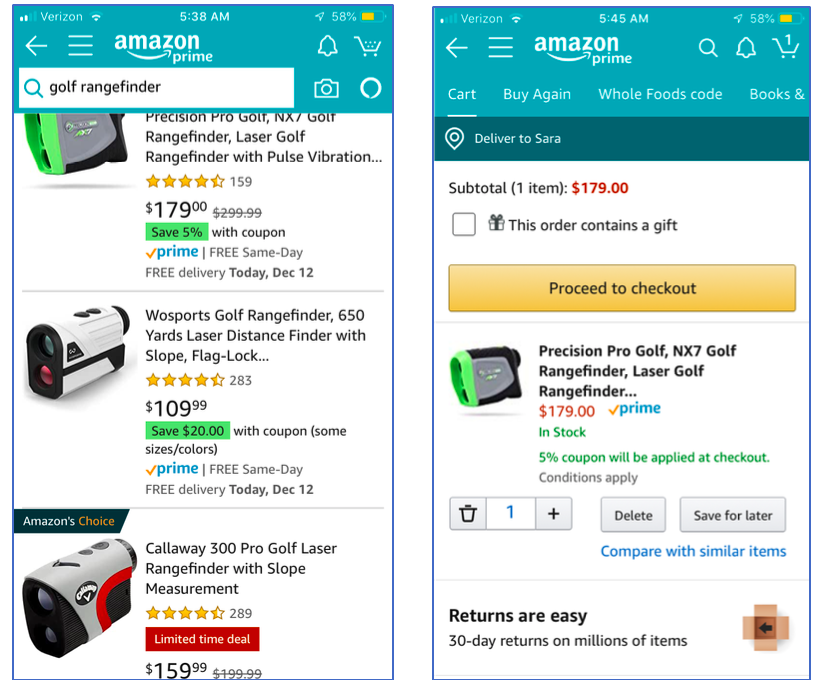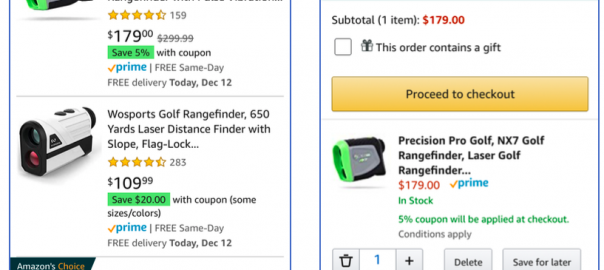
Amazon thinks I’m a coupon-driven shopper. They’re right.
If I’ve been mulling over a purchase, the whiff of a deal is often enough to push me over the edge. (And sometimes, to my husband’s chagrin, it’s enough to make me ask a retailer for a credit on a previous purchase… “But I paid double that (December 24, 2019)!”)
But back to Amazon – if there’s a coupon I can apply, I’m far more apt to buy something in the moment, congratulating myself on the bargain I’ve scored.
Lately, I’ve been seeing more coupons available to me, for items large and small, when shopping from my desktop or on the Amazon mobile app. Children’s toys for the holidays, trunk organizers and charging ports for our new car, golf rangefinders and more.
I’ve noticed these personalized coupons (all on non-subscription items) in various scenarios:
- For items I’ve engaged with, researched and added to my cart – but not purchased. When I return to my cart, there’s often a coupon to apply (and I clip it fast!).
- For other items I search for in that same category – there’s often an immediate coupon to click and clip.
- Even for new items I’m engaging with, I’ll often spot coupons – highlighted right below the item’s price.
Is this a strategy to increase business among shoppers around the holidays? Maybe. It’s also very possible that Amazon recognizes my buying behaviors and patterns, and what makes me convert – knowing I’m much more likely to stop vacillating, go ahead and buy, and buy from them if there’s a coupon I can take advantage of.

In the first image, a search for golf rangefinders highlights a number of deals I may be interested in. The second image shows one I’ve selected, with the coupon applied in my cart.
Amazon-Like Targeting for Any Online Business
For companies with Amazon-like aspirations for personalized coupons and promotions, Evergage helps them accomplish their goals.
Case in point: our award-winning machine-learning algorithm, Contextual Bandit, delivers split-second personalization that blends what’s best for each individual with what’s best for the business. Among other capabilities, it can determine which shoppers it makes sense to display promotions and discounts to (and how much), and who’s likely to convert without one – and then render experiences accordingly.
Contextual Bandit factors in deep behavioral data at the 1-to-1 level (e.g., an individual’s digital engagement, preferences, typical price point in a given category, intent, session context, etc.), and situational and attribute data (e.g., referring source, browser, device type, lifetime value, loyalty program status, geolocation, etc.). Then, faster than you can blink an eye, it:
- Estimates the probability of each person interacting with each available promotion.
- Applies continuous, sophisticated machine learning to predict the content or type of promotion for each visitor with the highest-value return.
- Presents each visitor with the optimal experience – considering promotion value and likelihood to engage.
Contextual Bandit even factors in “promotion-fatigue” – taking into account how often someone has seen a promotion without acting and learning the right time to show something new.
Digital & Social Articles on Business 2 Community
(51)
Report Post





